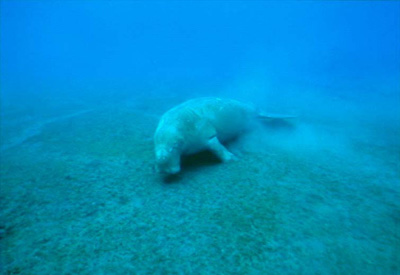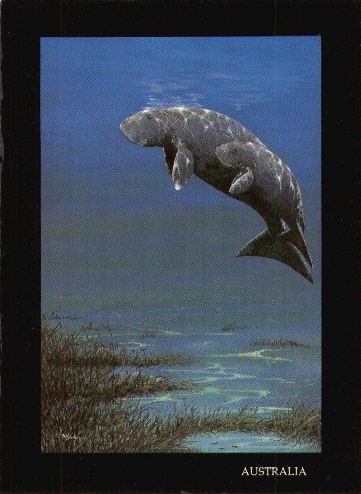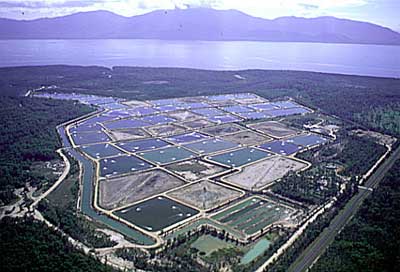


 | |||


 I. Identification
I. Identification More closely related to elephants than to whales or dolphins, the dugong's (Dugong dugon) closest aquatic relative is the manatee. Both belong to the order Sirenia in the mammal family. A typical dugong can reach three meters in length and weigh 400 kilograms. Dugong life spans are similar to humans with some dugongs reaching 70 years of age. Dugongs feed exclusively on seagrass meadows which, along with their bovine-like appearance, has earned them the nickname of 'sea-cow.'
More closely related to elephants than to whales or dolphins, the dugong's (Dugong dugon) closest aquatic relative is the manatee. Both belong to the order Sirenia in the mammal family. A typical dugong can reach three meters in length and weigh 400 kilograms. Dugong life spans are similar to humans with some dugongs reaching 70 years of age. Dugongs feed exclusively on seagrass meadows which, along with their bovine-like appearance, has earned them the nickname of 'sea-cow.'
Resembling a more robust, less streamlined dolphin or seal, dugongs are grey-bronze in color. Dugongs use their fluked tail for swimming and their front flippers for balance and turning. Their head is round with small eyes and large snout. Dugongs must surface to breath. However, unlike dolphins and whales, they are not able to hold their breath for long periods of time.

Dugongs are found in shallow tropical and subtropical waters of the Indo-Pacific region. They can be found in the waters of 43 countries, however, in many of these nations, the dugong population is tiny. Australia (approximately 80,000) and the Persian Gulf (approximately 7,500) have the largest dugong populations. In the Persian Gulf, the dugong can be found in the territorial waters of Bahrain, Qatar, Saudi Arabia and the UAE.
Dugongs reach sexual maturity between the ages of ten and seventeen. When a dugong has a calf, she nurses it for eighteen months or more. In general, the female dugong will reproduce once every three years, with single calf being the normal number of offspring.
In the Persian Gulf, as in the rest of their habitat area, the dugong faces numerous threats to its survival, most of them manmade. Furthermore, several of the dugong's natural traits increase their vulnerability to the negative stresses resulting from human activity.
The dugong's passive nature, its need to surface often, and its general habitat area all combine to make the animal vulnerable to hunting. Although hunting is not nearly the threat that it once was, the decline of the dugong throughout the world can be attribted, in part, to man's predation of the species. A close relative of the dugong, the Stellar Sea Cow, was indeed hunted into extinction in the late eighteenth century.
 Dugongs can hold their breath for roughly eight minutes. This fact, when taken in conjunction with the fact that dugongs feed in areas rich in commercially valuable fish and crustecean species, means that dugongs are at great risk of becoming tangled and drowned in fishing nets. Efforts aimed at protecting the dugong from such a fateoften curtail or prohibit fishing.
Dugongs can hold their breath for roughly eight minutes. This fact, when taken in conjunction with the fact that dugongs feed in areas rich in commercially valuable fish and crustecean species, means that dugongs are at great risk of becoming tangled and drowned in fishing nets. Efforts aimed at protecting the dugong from such a fateoften curtail or prohibit fishing.
 Due to its exclusive diet of sea grasses, the dugong is extremely vulnerble habitat loss. Scientific studies have demonstrated that where sea grass beds abound,Dugong populations tend to remain stable, whereas, when there is a scarcity of available grazing areas, dugong populations experience significant fluctuation. With the increasing population of the Persian Gulf, has come increasing development along the coastal areas of the region. The discharge of waste and the development of coastal areas by the tourism and aquaculture sectors have tremendous negative effects on the health and viability of the area's sea grass beds, and the consequences for the dugong can be severe.
Due to its exclusive diet of sea grasses, the dugong is extremely vulnerble habitat loss. Scientific studies have demonstrated that where sea grass beds abound,Dugong populations tend to remain stable, whereas, when there is a scarcity of available grazing areas, dugong populations experience significant fluctuation. With the increasing population of the Persian Gulf, has come increasing development along the coastal areas of the region. The discharge of waste and the development of coastal areas by the tourism and aquaculture sectors have tremendous negative effects on the health and viability of the area's sea grass beds, and the consequences for the dugong can be severe.
 One of the most constant threats posed to the dugongs of the Persian Gulf is that of water pollution, most especially water pollution as a result of oil spills. With an enormous amount of the world's oil supplies located in the Persian Gulf region, the transport of oil through the Persian Gulf is a fact of life. So too are oil spills. Oil in the water of the Persian Gulf destroys dugong habitats and is likley to have significant direct negative health effects on the dugong.
One of the most constant threats posed to the dugongs of the Persian Gulf is that of water pollution, most especially water pollution as a result of oil spills. With an enormous amount of the world's oil supplies located in the Persian Gulf region, the transport of oil through the Persian Gulf is a fact of life. So too are oil spills. Oil in the water of the Persian Gulf destroys dugong habitats and is likley to have significant direct negative health effects on the dugong.
Throughout the Persian Gulf, efforts are underway to preserve the dugong for future generations. While only Saudi Arabia and the UAE are parties to the CITES agreement, both Bahrain and Qatar havelaws designed to protect the dugong. Several factors have combined to make dugong conservation more difficult. The nations of the Gulf are hampered by a lack of information relating to almost every facet of dugong life. In recent years, several efforts have been initiated in order to learn more about dugong patterns of movement, feeding habits, population levels,and other factors of concern for those working to preserve the dugong.
 II. Legal Clusters
II. Legal Clusters III. Geographic Clusters
III. Geographic Clusters10. Sub-National Factors:
11. Type of Habitat:
 IV. Trade Clusters
IV. Trade Clusters12. Type of Measure:
13. Direct v. Indirect Impacts:
14. Relation of Trade Measure to Environmental Impact
15. Trade Product Identification:
16. Economic Data
17. Impact of Trade Restriction:
18. Industry Sector:
19. Exporters and Importers:
 V. Environment Clusters
V. Environment Clusters20. Environmental Problem Type:
21. Name, Type, and Diversity of Species
22. Resource Impact and Effect:
23. Urgency and Lifetime:
24. Substitutes:
 VI. Other Factors
VI. Other Factors25. Culture:
26. Trans-Boundary Issues:
27. Rights:
28. Relevant Literature